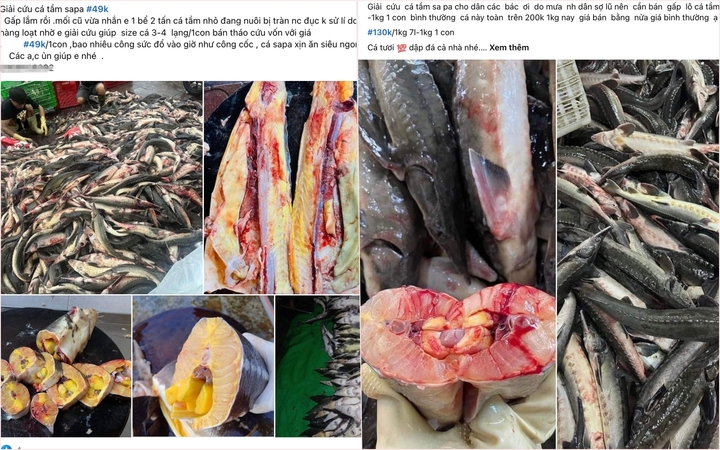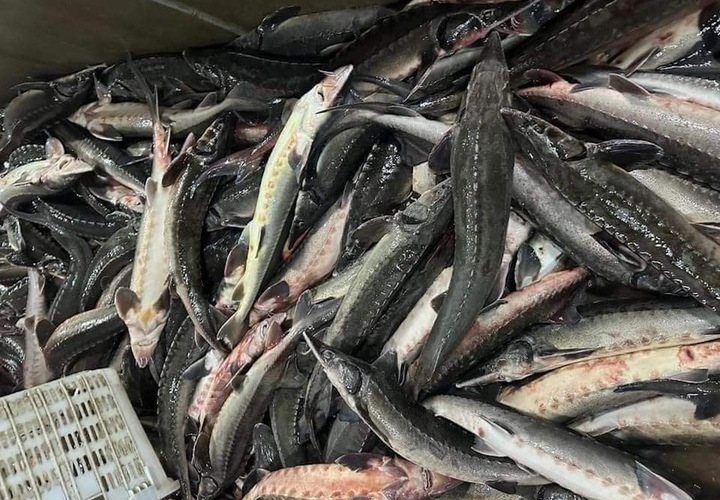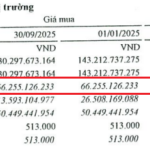Sturgeon has long been known as a delicacy with prices no less than VND 250,000/kg. Sturgeon caviar can even reach VND 200 million/kg. However, recently, the market has witnessed the appearance of super cheap sturgeon. Accordingly, for only VND 49,000, consumers can buy this fish, once dubbed the “black gold” of seafood.
Specifically, sturgeon weighing 1-2.5 kg is sold at a price range of VND 100,000 – 150,000/kg, while smaller ones are priced from only VND 49,000 – 65,000 each (usually weighing about 300 grams) surprising many.
According to the sellers, this is a “rescue” sturgeon originating from Sapa, Lao Cai. The sturgeon farms were affected by floods, with mud flowing into the ponds and weakening the fish, prompting the farmers to sell them off quickly.
On online markets, this super cheap sturgeon is advertised as very tasty and boneless. Under each post, there are dozens, if not hundreds, of people placing orders. Some buy as little as 3-5 fish, while others purchase up to several dozen at a time.

Sturgeon from Sapa being sold for “rescue” prices online. (Screenshot)
“I have some Sapa sturgeon, super delicious, and I’m selling it for only VND 65,000 each (around 500g), guaranteed fat and fresh. Sturgeon has no bones, so it’s suitable for the elderly and children. Its spine is made of cartilage, which is crunchy and tasty!” said Lan Huong, an online sturgeon seller.
Seeing the affordable price and clear origin, Ms. Thu Trang from Dong Da, Hanoi, bought two fish to try. Finding them delicious, she ordered almost a dozen more the next day. “The VND 49,000/kg ones are very small, only about three fingers long, and not so tasty. For a better experience, go for the 1-2 kg ones; you get what you pay for,” she shared.
Some other sellers, like Ms. Phuong from Hoang Mai, Hanoi, even offer younger sturgeon at a rock-bottom price of VND 49,000 each. She explained, “All these sturgeon are being sold to help the farmers in Sapa affected by the third storm of the year. After the storm, their ponds were flooded with a large amount of water, mud, sand, and gravel, causing the fish to choke and become weak, so they needed to be sold quickly.”
Ms. Phuong further shared that her current supply could provide about 4-5 tons per day, but it would only last a few more days. She has been advertising the sturgeon on online markets at VND 49,000 – 65,000 each for those weighing 300 – 500g, and VND 85,000 each for those around 600-700g.

Young sturgeon a few months old are sold for only VND 49,000 each.
Mr. Tan Lu Quay from Lien Minh, Sapa, Lao Cai, shared that after the Yagi storm, the floodwaters caused landslides, affecting all 29 of his sturgeon ponds. “Some were buried in the landslide, while others were swept away by the flood. We estimate a loss of about 60 tons of fish,” said Mr. Quay.
As for the remaining sturgeon, Mr. Quay has been nursing them for about four months now, and they weigh around 300-700g each. A few days ago, tens of thousands of these young fish died due to an unsuitable living environment, forcing Mr. Quay to sell them at a meager price of VND 5,000/kg. Additionally, he had to sell off the surviving fish at VND 30,000 – 60,000/kg, depending on their size.
In the market, sturgeon prices typically range around VND 500,000/kg. Mr. Nguyen Huu Trang, Director of The Gioi Hai San (Seafood World), shared that sturgeon of good quality should be of a certain age and raised for an extended period, usually 10 – 12 months. “At The Gioi Hai San, we still offer swimming sturgeon at VND 499,000/kg, weighing around 1.8 kg,” he said.
Other seafood businesses, such as Dao Hai San, sell sturgeon at VND 620,000/kg for those weighing 1.7 kg and VND 703,000/kg for those at 1.9 kg. Hai San Hoang Gia, on the other hand, offers fresh sturgeon at VND 395,000/kg.
Mr. Nguyen Huu Trang advised consumers to be cautious when purchasing cheap sturgeon online. It is likely that these fish have not met the quality standards for sale. Moreover, by the time the fish reaches the buyer, it has already been processed and is no longer swimming, making it impossible to verify its freshness. Another concern is the potential misrepresentation of the fish’s origin, so buyers need to be vigilant.





































